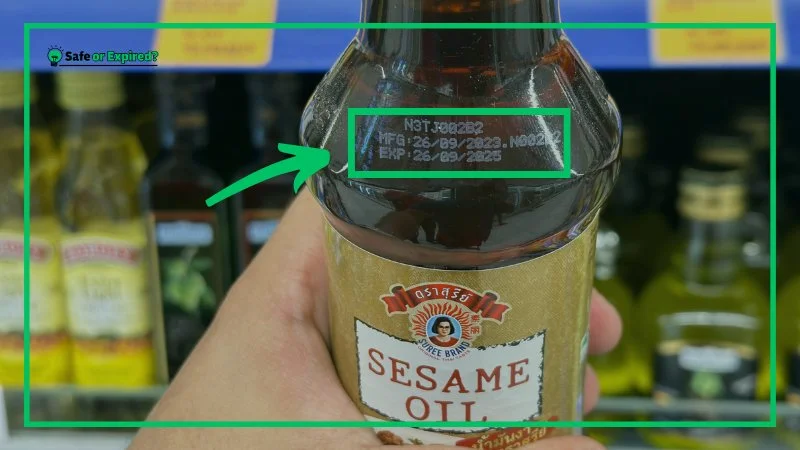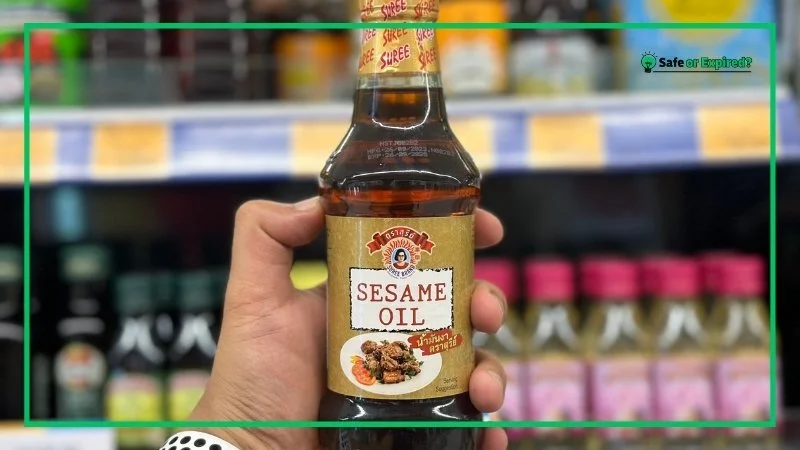“Does sesame oil go bad?” is a legitimate concern and the answer is yes, it can. Signs of spoilage include a rancid smell, a bitter taste, and a cloudy or thickened consistency. In this article, I’ll show you how to keep your sesame oil fresh longer and what to do with expired oil. Stay tuned for some simple tips to extend its shelf life!
Does Sesame Oil Go Bad?
Yes, sesame oil can go bad. Its shelf life depends on storage conditions and whether it’s opened or unopened. Over time, sesame oil may become rancid due to oxidation. You can tell it’s gone bad if it develops an off smell or taste.
Moreover, there’s an expiration date printed on the oil bottle. After this date, the sesame oil can be termed “bad.”

Now, let’s discuss some of the most asked queries about sesame oil shelf life.
Does Sesame Oil Go Bad if Unopened?
Unopened sesame oil has a longer shelf life than opened oil, typically lasting 1-2 years. However, it can still go bad if exposed to heat, light, or air. Check for an off smell or taste to determine if it’s spoiled.
Does Sesame Oil Go Bad in the Fridge? Yes or No?
Refrigeration can extend the shelf life of sesame oil, but it can also cause it to become cloudy or solidify. This doesn’t necessarily mean it’s spoiled; warming it up usually restores its normal consistency. If sesame oil is kept in the fridge, it can last up to 2 years, but always check for a foul smell to ensure it hasn’t gone bad.
Does Sesame Oil Go Bad if Not Refrigerated?
Sesame oil can go bad if not refrigerated, especially in warm climates. If stored at room temperature, it typically lasts 6 months to a year. To prevent spoilage, store it in a dark location and keep the bottle tightly sealed.
How Long Does Sesame Oil Last Once Opened?
Once opened, sesame oil’s shelf life shortens. It generally lasts 6 months to a year when stored in a cool, dark place with the bottle tightly sealed. Refrigeration can extend its shelf life. Check for spoilage, like an off smell or taste, to determine if it’s still good. If you detect any of these signs, it’s best to discard the oil.
Here’s a table showing the shelf life of sesame oil under different conditions.
| Counter | Fridge | |
| Opened | 6 months to 1 year | Up to 2 years |
| Un-Opened | 1 to 2 years | Up to 2 years or more |
Are you also wondering about other oils in your kitchen? Take vegetable oil, for example. It’s another staple, but how long does it last, and how should you store it? Find out in “Does Vegetable Oil Go Bad, and How To Keep It Fresh?”
What Are the Factors that Impact Sesame Oil’s Shelf Life?
The shelf life of sesame oil is affected by storage conditions, whether the oil is opened or unopened. Moreover, environmental factors like temperature can also play their part. Oxidation and exposure to heat can cause sesame oil to spoil faster, leading to rancidity.
Temperature
Temperature plays a significant role in sesame oil’s shelf life. When stored in a warm environment, the oil can go bad more quickly due to accelerated oxidation. Heat causes the oil to break down, resulting in a rancid taste and odor.
Oil’s Composition
Sesame oil’s composition plays a significant role in its shelf life. It contains fatty acids, vitamins, and antioxidants, all of which influence how quickly it degrades. The presence of natural antioxidants like sesamin and sesamol helps to prevent oxidation, extending the oil’s shelf life.
However, the high content of unsaturated fatty acids, particularly linoleic acid, can lead to rancidity if not stored properly. You can check the sesame oil’s composition on its bottle:

Light Exposure
Light exposure is another factor that affects sesame oil’s shelf life. Ultraviolet (UV) rays can cause the oil to degrade, leading to spoilage. This process, known as photo-oxidation, can give sesame oil an unpleasant smell and taste.
To avoid this, store sesame oil in a dark bottle or cabinet. If you choose to refrigerate it, ensure it’s in an opaque container. It will minimize light exposure.
Air Exposure
Air exposure can also reduce the shelf life of sesame oil. Oxygen in the air reacts with the oil, causing it to oxidize and become rancid. This process is known as oxidation, which leads to spoilage. To prevent air exposure, always keep the bottle tightly sealed.
Bottle’s Condition
The condition of the bottle can significantly affect the shelf life of sesame oil. A well-sealed, airtight bottle helps to prevent exposure to:
- Air
- Moisture
- Contaminants.
Additionally, the material of the bottle is crucial. Dark glass bottles offer better protection against light. In contrast, plastic bottles may leach chemicals into the oil over time, affecting its quality and shelf life. Always remember that properly sealed, high-quality glass bottles are ideal for maintaining sesame oil’s freshness.
Here’s a picture of good-quality sesame bottle:

Contamination
Contamination is another reason why food items get spoiled. If impurities or bacteria enter the oil, it can spoil quickly. This can happen if the oil is not stored properly or if utensils are not clean when used with the oil. To avoid contamination, use clean utensils and ensure the bottle is sealed after each use. Avoid dipping food or other items into the oil bottle to prevent introducing contaminants.
Now, you can take steps to extend the shelf life of sesame oil and enjoy its flavor and benefits for longer.
Can Expired Sesame Oil Make You Sick? Let’s Find Out
Expired sesame oil can make you sick if it has become rancid or contaminated. Rancidity occurs when the oil oxidizes, developing a foul smell and taste. Consuming rancid oil may cause:
- Stomach upset
- Nausea
- Digestive issues.
Additionally, if the oil is contaminated with bacteria or mold, it could lead to over 200 foodborne diseases. Always check the oil’s smell, taste, and appearance before using it. If it smells bad or looks cloudy or thickened, it’s best to discard it to avoid potential health risks.
How Long Does Sesame Oil Last After Expiration Date? Know the Answer
Sesame oil can last beyond its expiration date if stored properly, but it’s not guaranteed to be safe or of good quality. Typically, unopened sesame oil can last 6 months to a year past its expiration date if kept in a dark place.
However, if the oil smells rancid, tastes off, or shows signs of contamination, it’s best to discard it. Opened sesame oil generally has a shorter shelf life after expiration, lasting a few months if stored well. Always use your senses to determine if it’s still good, and when in doubt, throw it out.
How to Confirm Sesame Oil Has Gone Bad? Explaining All the Signs
You can confirm if sesame oil has gone bad by its smell, taste, and appearance. A rancid odor, bitter or sour taste, or a cloudy and thickened consistency are clear signs of spoilage. Also, check for mold or other contamination, which can make the oil unsafe to consume.
Rancid Smell
Ever wondered, “Why does sesame oil smell so bad?” Well, a rancid smell is a strong indicator that sesame oil has gone bad. Fresh sesame oil has a nutty, aromatic scent, but when it spoils, it develops a sharp, unpleasant odor.
This change in smell occurs because of oxidation, where the oil’s fatty acids break down due to exposure to air or heat. If you notice a rancid or sour smell, it’s a sign that the oil is no longer good.
Bitter or Sour Taste
The taste of sesame oil can also indicate whether it’s gone bad. Fresh sesame oil has a rich, nutty flavor, but when it spoils, it becomes bitter or sour. This change in taste is a result of oxidation and rancidity. If the oil has a strange or unpleasant taste, it’s best to avoid using it in your food.
Cloudy or Thickened Consistency
Sesame oil should have a clear and smooth consistency. If it becomes cloudy, thickened, or clumpy, it could be a sign that it’s gone bad. This often occurs when the oil has been stored in the fridge for a long time or has oxidized due to air exposure.
While some cloudiness from refrigeration can be normal, a noticeable change in consistency can indicate spoilage.
Mold or Other Contamination
Mold or visible contaminants are a definite sign that sesame oil has gone bad. This can happen if the oil is not stored properly or if it’s contaminated by unclean utensils. If you see any mold, particles, or discoloration in the oil, it’s best to discard it immediately. Moldy or contaminated oil can cause foodborne illness and should not be used under any circumstances.
By paying attention to these signs, you can avoid using spoiled sesame oil and ensure your cooking is safe and healthy. If in doubt, trust your senses—smell, taste, and look at the oil to determine if it’s still good. If it doesn’t seem right, it’s better to be safe and throw it away.
What To Do With Expired Sesame Oil?
Expired sesame oil should not be used for cooking or consumption. Instead, you can use it for non-food purposes like oiling garden tools, lubricating squeaky hinges, or as a base for homemade cleaning products. Always ensure it’s not rancid or contaminated before use.
Non-Food Uses
Expired sesame oil can still be useful for various non-food purposes. For instance, it can be used to oil garden tools, which helps prevent rust and keeps them working smoothly.
You can also use it to lubricate squeaky hinges on doors or furniture. The oil’s natural lubricating properties make it ideal for these tasks. Just make sure it’s not rancid or contaminated before using it in this way.
Cleaning Products
Another great way to repurpose expired sesame oil is in homemade cleaning products. You can mix the expired oil with vinegar or lemon juice to create a wood polish or surface cleaner. This is a sustainable way to use expired oil instead of throwing it away.
Before using it for cleaning, ensure it doesn’t have a rancid smell or visible impurities, as this can affect the cleanliness of your surfaces.
Safe Disposal
If the expired sesame oil has a rancid smell, bitter taste, or shows signs of contamination, it’s best to dispose of it safely. You should never pour sesame oil down the drain. Why? Well, it can clog pipes and harm the environment. Instead, you should pour it into a sealable container. After this, you can safely throw it in the trash.
Alternatively, check with your local waste management for proper oil disposal guidelines. This ensures you’re not causing harm to the environment when getting rid of expired oil.
By following these tips, you can repurpose expired sesame oil for non-food uses and ensure safe disposal when needed. This not only helps reduce waste but also minimizes the risk of foodborne illness from consuming expired or rancid oil.
How to Store Sesame Oil To Extend Its Shelf Life? Easy Tips
To extend sesame oil’s shelf life, store it in a cool, dark place away from direct sunlight. Keep the bottle tightly sealed to minimize air exposure and prevent oxidation. Refrigeration can help extend shelf life but may cause cloudiness. Always use clean utensils when handling the oil to avoid contamination.
Keep It Cool and Dark
Storing sesame oil in a cool, dark place is key to extending its shelf life. Heat and sunlight can cause the oil to oxidize, leading to spoilage and rancidity. Find a spot in your kitchen or pantry that’s away from direct sun rays and heat sources like stoves or ovens. This will help maintain the oil’s quality and prevent it from going bad prematurely.
Tightly Seal the Bottle
Air exposure is one of the primary causes of sesame oil spoilage. To prevent this, always keep the bottle tightly sealed when not in use. This minimizes oxidation and helps the oil stay fresh longer. If you’re using a large bottle, consider transferring the oil to smaller containers to reduce the amount of air inside. This also makes it easier to manage and use over time.
Use Refrigeration
According to food safety guidelines from top institutions, refrigeration can help maximize the shelf life of oil, especially once it’s opened. While refrigeration may cause the oil to become cloudy or solidify, this doesn’t affect its quality. Just let it warm up to room temperature, and it’ll return to its normal consistency.
If you store sesame oil in the fridge, use an opaque container to minimize light exposure and keep the oil away from strong-smelling foods.
Avoid Contamination
Contamination can shorten the shelf life of sesame oil. Always use clean utensils when handling the oil to prevent introducing impurities or bacteria. Avoid dipping food or other items into the bottle, as this can lead to contamination. If you need to measure oil, pour it into a separate container first to avoid contaminating the original bottle.
By following these storage tips, you can extend the shelf life of sesame oil and ensure it stays fresh and safe to use. Proper storage not only helps you get the most out of your oil but also reduces the risk of spoilage and foodborne illness.
Conclusion
In summary, sesame oil does go bad. To prevent it, follow these key points:
- Store it in a cool, dark place to reduce the risk of spoilage.
- Keep the bottle tightly sealed to limit air exposure.
- Refrigerate the sesame oil to extend its shelf life, but expect some cloudiness.
- Use clean utensils to prevent contamination.
- Discard the oil if it smells rancid or shows signs of impurities.
By following these tips, you can keep your sesame oil fresh and avoid any issues with spoilage. Proper storage and handling can help you enjoy sesame oil for a longer time without worrying about it going bad.

